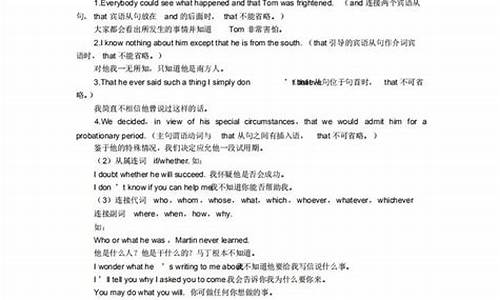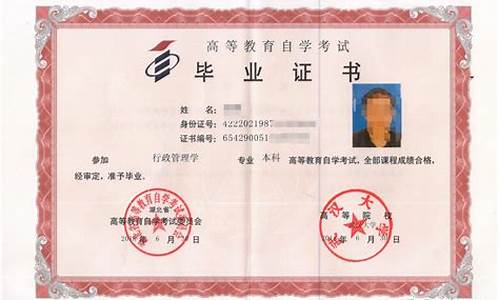您现在的位置是: 首页 > 教育分析 教育分析
从句高考英语_从句高考英语真题
tamoadmin 2024-05-26 人已围观
简介1.高考英语状语从句问题2.高三英语复习从句总结,简练点。3.高考英语语法:高中英语语法-语法·表语从句用法小结4.高考英语语法:由关系副词when,where,why引导的定语5.英语 名词性从句 高考 help状语从句 (Adverbial Clause) 一 状语从句的种类 § 1状语从句的种类 用来修饰谓语动词、其它动词、定语、状语或整个句子的从句叫做状语从句。状语从句可分为: 1.时间状
1.高考英语状语从句问题
2.高三英语复习从句总结,简练点。
3.高考英语语法:高中英语语法-语法·表语从句用法小结
4.高考英语语法:由关系副词when,where,why引导的定语
5.英语 名词性从句 高考 help

状语从句
(Adverbial Clause)
一 状语从句的种类
§ 1状语从句的种类
用来修饰谓语动词、其它动词、定语、状语或整个句子的从句叫做状语从句。状语从句可分为:
1.时间状语从句;(adverbial clause of time)
2.地点状语从句;(adverbial clause of place)
3.原因状语从句;(adverbial clause of cause)
4.条件状语从句;(adverbial clause of condition)
5.目的状语从句;(adverbial clause of purpose)
6.让步状语从句;(adverbial clause of concession)
7.比较状语从句;(adverbial clause of comparison)
8.程度状语从句;(adverbial clause of degree)
9.方式状语从句;(adverbial clause of manner)
10.结果状语从句。(adverbial clause of resu lt)
§2状语从句的时态特点
一般情况下,时间和条件状语从句的谓语动词一般用“一般现在时”表示“一般将来时”,用“现在完成时”表示“将来完成时”。例如:
I will call you as soon as I arrive in Beijing. 我一到北京就给你打电话。(这是由as soon as引导的时间状语从句,从句中的谓语动词arrive是一般现在时,表示一般将来时,决不可用will arrive)
As soon as I have finished this work, I will go home. 我一完成此工作,就回家。(从句中的谓语动词用现在完成时have finished,表示将来完成时,决不可用will have finished)
If he comes back, please let me know.如果他回来了,请通知我。(从句中的谓语动词用comes back,表示一般将来时,决不可用will come back)
二 时间状语从句
§3时间状语从句(adverbial clause of time)
1.由when, while, as引导的时间状语从句。例如:
When you think you know nothing, then you begin to know something.当你以为自己一无所知的时候,你就是在开始知道一些事物了。
When truth is buried under the ground it grows, it chokes, it gathers such an explosive force that on the day it bursts out , it blows up everything with it.当真理被埋在地下的时候,它在生长,它感到压抑,它蓄存着这么一种爆炸性力量,一旦冒出,它就会炸破一切!
Strike while the iron is hot. 趁热打铁。
Will you watch my clothes while I have a swim. 我游泳的时候,请你照看一下我的衣服。
You can feel the air moving as your hand pushes through it. 当你的手在空气中挥动的时候,你就能感觉到空气在流动。
Our headmaster laughed as she spoke.我们的校长边谈边笑。
区别when, while和as的区别:when引导的从句的谓语动词可以是延续性的动词,又可以是瞬时动词。并且when有时表示“就在那时”。例如:
When she came in, I stopped eating.她进来时,我在吃饭。(瞬时动词)
When I lived in the countryside, I used to carry some water for him.当的住在农村时,我常常为他担水。(延续性的动词)
We were about to leave when he came in.我们就要离开,就在那时他进来了。
While引导的从句的谓语动作必须是延续性的,并强调主句和从句的动作同时发生(或者相对应)。并且while有时还可以表示对比。例如:
While my wife was reading the newspaper, I was watching TV.
高考英语状语从句问题
《高中英语语法-语法·同位语从句用法小结(2)》由liuxue86.com我整理。本内容整理时间为05月12日,如有任何问题请联系我们。
语法?同位语从句用法小结(2)
四、同位语从句的语气
在suggestion,advice,request,order等意为?建议;命令;要求?的名词后,同位语从句中的谓语动词通常用?should +动词原形?的虚拟语气结构,句中的should可以省略。例如:
Our teacher gave us some advice how we(should)use the computer. 老师给我们提出了一些如何使用电脑的建议。
The suggestion came from the chairman that the new rule(should)be adopted. 采纳新规则的建议是主席提出来的。
The government gave the order that all these houses(should)be pulled down in three weeks. 政府下令三个星期内所有这些房子都要拆掉。
五、同位语从句与定语从句的用法区别
区别(1)
同位语从句和先行词是同等的关系;而定语从句是用来修饰先行词,是从属的关系。
区别(2)
that在同位语从句中没有词义,不充当句子成分;而在定语从句中充当主语、宾语等句子成分。
区别(3)
whether,what,how可以用来引导同位语从句;而它们不能用来引导定语从句。
区别(4)
1. 从词义角度看问题
who,whom,which,when,where,why用来引导同位语从句是保持原来疑问词的含义;它们用来引导定语从句时,不具有疑问词的含义。
2. 从搭配角度看问题
who,whom,which,when,where,why用来引导定语从句时对应性很强,如:
先行词是?人?,引导词用?who?等,而它们引导同位语从句是先行词通常是?question,idea,doubt等?。
六、典型例题
例1:I have no idea when he will be back.
析:he will be back意义不完整,应加?什么时候?的含义才能表达idea的全部内容,因此应用when引导同位语从句。
例2:I have no impression how he went home,perhaps by bike.
析:he went home意义不完整,应加?如何?的含义才能表达impression的全部内容,因此应用how引导同位语从句。
例3:Information has been put forward ____ more middle school graduates will be admitted into universities.(NMET2001上海)
A.while B.that C.when D.as
析:答案为B.more middle school graduates will be admitted into universities是Information的内容,且Information不在从句中作成分,所以该句为同位语从句。应将该句区别于:
It is said that more middle school graduates will be admitted into universities,this is the information ____ has been put forward.
A.what B.that C.when D.as
析:答案为B.that has been put forward为information的修饰性定语,且information在从句中作主语,所以该句为定语从句。
例4:She heard a terrible noise,____ brought her heart into her mouth.(MET91)
A.it B.which C.this D.that
析:答案为B.分析语境含义、句子结构和句子成分可知,该句为非限制性定语从句,先行词为a terrible noise,且它在从句中作主语。应将该句区别于:
I can?t stand the terrible noise ____ she is crying loudly.
A.it B.which C.this D.that
析:答案为D.she is crying loudly是the terrible noise的内容,且the terrible noise不在从句中作成分,所以该句为同位语从句。
重要链接:同位语从句专项语法习题
[1][2] 《高中英语语法-语法·同位语从句用法小结(2)》由liuxue86.com我整理
高三英语复习从句总结,简练点。
Put the book where it was.直译的话就是“把书放到它刚才的那个地方”。where it was 是表地点的地点状语从句,做动词put的地点状语。其中,where是地点状语从句的表语成分,所以不缺成分的
Put the book in the place where it was。与上面那句是同一句,where仍旧做表语,副词可以做表语,不一定要that才能做表语。这句where也可以替换为in which
高考英语语法:高中英语语法-语法·表语从句用法小结
定义
I. 定语从句起形容词的作用,在句中修饰一个名词或代词。被修饰的词叫做先行词,引导定语从句的词叫关系词,他的作用一是放在先行词与定语从句中间起了连接作用,二是在从句中担当一个成分,并与先行词保持数的一致。
关系词 先行词 从句
成分 例句 备注
关系代词 who 人 主语 Do you know the man who is talking with your mother? whom, which和that在从句中做宾语时,常可以省略,但介词提前时后面关系代词不能省略,也不可以用that
whom 人 宾语 Mr. Smith is the person with whom I am working
The boy (whom) she loved died in the war..
whose 人,物 定语 I like those books whose topics are about history.
The boy whose father works abroad is my desk mate.
that 人,物 主语
宾语 A plane is a machine that can fly.
She is the pop star (that) I want to see very much.
which 物 主语
宾语 The book (which) I gave you was worth $10.
The picture which was about the accident was terrible.
as 人,物 主语
宾语 He is such a person as is respected by all of us.
This is the same pen as I lost yesterday. as做宾语一般不省略
关系副词 when 时间 时间
状语 I will never forget the day when we met there. 可用on which
where 地点 地点
状语 This is the house where I was born. 可用in which
why 原因 原因
状语 I can’t imagine the reason why he turned down my offer. 可用for which
Ⅱ. as与which的区别:
定语
从句 区别 例句
限制性定语从句 中 名词前有such和the same修饰时,关系代词用as,不能用which He is not such a fool as he looks.
Don’t read such books as you can’t understand.
非限制性定语从句中 as和which都可以指代前面整个主句。如果有“正如,象”的含义,并可以放在主句前,也可以放在后面,那么用as;而which引导的从句只能放主句后,并无“正如”的意思。 They won the game, as we had expected.
They won the game, which we hadn’t expected.
As is well known, he is a famous film star in the 1980s.
Ⅲ. 限制性定语从句与非限制性定语从句的区别:
类别 语法意义及特征 例句
限制性定语从句 对先行词起修饰限制作用,如果去掉,主句意思就不完整明确,这种从句与主句的关系十分密切,写时不用逗号分开。 The accident happened at the time when I left.
非限制性定语从句 对先行词作附加的说明,与主句的关系不十分密切,较松散。从句和主句之间用逗号分开,相当于一个插入语,不能用that引导,关系代词做宾语时也不能省略。 His mother, whom he loved deeply, died ten years ago.
一、考点聚焦
1、功能:相当于形容词,修饰名词或代词,在句中作定语
2、位置:定语从句置于被修饰词之后
Those who are willing to attend the party, sign here please.
3、先行词:被定语从句修饰的词称为先行词
(1)先行词一般是名词和不定代词,如:some-, any-, every-和no与-boy, -thing的合成词;或all、none、any、some、that、those等代词。数词也可以作先行词,人称代词也同样可作先行词。
(2)先行词与关系词是等量关系。必须注意两点:
①先行词在从句中作主语时,从句谓语动词的数由先行词而定。
This is the place which is worth visiting.
②关系词在从句句子中充当了成分,其意思就是先行词的意义,所以在从句中不能重复其意。
There are many places we can visit(them)in China.
4、关系词:引导定语从句的都称关系词
关系代词:who, whom, which, that, whose, as。
关系副词:when, where, why。that偶尔也作关系副词。
5、确定关系词的步骤
(1)先找关系词,看先行词指的是什么。
(2)看关系词在从句中所充当的成分。
6、在定语从句中,当先行词指物时,下列情况的关系词宜用that而不用which
(1)先行词被①形容词最高级 ②序数词 ③数词几种词修饰或被 ④only、any、few、little、no、all、one of等修饰时。
(2)先行词为all、much、little、none、few、one、something、anything等不定代词时。
(3)先行词中既有人又有物时。
He was looking pleasantly at te children and parcels that filled his bus.
(4)先行词在主句中作表语关系词在从句中作表语时。
The village is no longer the one that was 5 years ago.
(5)当主句中含有疑问词which时。
Which are the books that you bought for me ?
7、宜用which而不用that的情况
(1)在非限制性定语从句中
(2)在关系词前有介词时
(3)当先行词本身是that时
(4)当关系词离先行词较远时
8、关系词who与that指人时,也有不同情况分别用不同的关系词
(1)当主句是there be句型时,关系词用who。
(2)先行词是为anyone、those、someone、everyone、one等词时,关系词用who。
(3)当主句是who作疑问词时,关系词用that。
Who is that girl that is standing by the window?
(4)whom在从句中只作宾语,可被who取代。
9、whose作关系词既指人又指物,在从句中作定语。如:
Do you know Mr. Smith whose story is very moving?
There is a room, whose window faces the river.
There is a room, the window of which faces the river.
10、关系代词as,在从句中作主语、宾语和表语。
(1)先行词被such和the same修饰,或句型as many(much)中,从句都用as 引导。
Such books as you bought are useful. The school is just the same as it was 10 years age.
注意:区别①such … that … 引导的结果状语从句。They are such lovely children that we love them much .②the same … that … 引导定语从句。I want to use the same tool that you used just now.
(2)无先行词的定语从句用as和which引导。
区别:①意义上:as 含有“这点正如……一样”。②位置上:as 从句可置句首,也可在另处。
He didn’t pass the exam, as we had expected.
There is lots of air in loose snow, which can keep the cold out.
As is known, the earth is round, not flat.
11、关系副词when与where、why、that
when 指时间 = in / at / on / during which
where指地点 = in / at / from / which
why指原因 = for which
当先行词为way、day、reason、time时,可用that作关系副词。(非正式场合)
I don’t like the way that / in which / he talks.
当time作先行词时,关系词可以省掉。
This is the first time I have given you a lesson in French.
12、必须注意的问题
(1)关系词作主语时,从句中谓语的数。
(2)注意区别定语从句与强调句。
①定语从句中关系词作从句成分,复合句。
②强调it无意义,that / who不是引导词。
③强调it is / was和that / who后如果句子意思讲得通则是强调句,讲不通则不是。
It is the museum that / which we visited last year.(定语从句)
It was in the hotel that we stayed last night.(强调句)
(3)定语从句与同位语从句的区别。
①定语从句引导词被称为关系词,that充当主语、宾语、表语。有时可省略。
②同位语从句引导词被叫做连词,that不能充当任何成分,不可省。
Word came that their army was defeated.(同位语)
We expressed to them our wish that was the same as their.(定语)
(4)关系词在从句中省略的情况。
①关系词作宾语,前无介词时。
②关系词作表语。
(5)限制性定语从句与非限制性定语从句的翻译。
(6)关系词前有介词或复杂介词,关系词只能是which和whom。
(7)几个特殊的定语从句句型:
①He is the only one of the students who has got very good marks in the match.(句中one为先行词)
He is one of the students who have got good marks in the match.(句中students为先行词)
②Is this place the one (that) we visited yesterday? Is this the place (that / which) we visited yesterday?
③He stood at the window, from where he could see what was happening.
④It may rain, in which case the match will be put off.
二、精典名题导解
1. The film brought the hours back to me _________ I was taken good care of in that faraway village.(NMET 2001)
A. until B. that C. when D. where
解析:答案为C。本题考查分隔定语从句的关系词的选择。作好本题的关键是要能辨认出该定语从句的先行词the hours和关系词被介词短语to me所分隔。定语从句的先行词是表时间的名词hours, 并且关系词在从句中用作状语,故应选择表示时间的关系副词when。
2. ___________ is known to everybody, the noon travels around the earth once every month.(NMET 2001)
A. It B. As C. That D. What
解析:答案为B。本题考查as引导的非限制定语从句。as作“正如……”解时,引导的非限制性定语从句来修饰整个句子。当as在从句中作主语时,常用于下列短语:as is known、as is said、as is reported、as is announced等。要注意掌握作关系代词引导定语从句的用法。
3. After living in Pairs for fifty years he returned to the small town ___________ he grew up as a child.(NMET 1996)
A. which B. where C. that D. when
解析:答案为B。本题考查限制性定语从句中关系词的选择。定语从句的先行词是表示地点的名词短语the small town, 且关系词不作定语从句中的主语和宾语而作地点状语,因此定语从句必须用关系副词where引导。要注意分清先行词在从句中充当的成分,然后选择适当的关系词。
高考英语语法:由关系副词when,where,why引导的定语
《高中英语语法-语法·表语从句用法小结》由出国留学我精心为您学习英语准备.liuxue86.com。本内容整理时间为05月12日,如有任何问题请联系我们。
语法?表语从句用法小结
一、表语从句的定义:
表语从句放在连系动词之后,充当复合句中的表语。
二、表语从句的构成:
关联词+简单句
三、引导表语从句的关联词的种类:
1. 可接表语从句的连系动词有be,look,seem,sound,appear等。
China is no longer what she used to be.
今日的中国不再是过去的中国了。
The question remains whether they will be able to help us.
问题还是他们能否帮我们。
At that time,it seemed as if I couldn't think of the right word.
当时,我似乎怎么也想不出一个恰当的字眼来。
2. 从属连词whether,as,as if / though引导的表语从句。
He looked just as he had looked ten years before.
他看起来还与十年前一样。
It sounds as if someone is knocking at the door.
听起来好像有人在敲门。
3. because,why引导的表语从句。
That's because he didn't understand me.
那是因为他没有理解我。(That's because?强调原因)
That's why he got angry with me.
那正是他对我生气的原因。(That's why?强调结果)
what引导的主语从句表示结果或名词reason作主语时,后面的表语从句表示原因时要用that引导,不宜用because.
The reason why I was sad was that he didn't understand me.
我难过的原因是他没有理解我。
4. 连接代词who,whom,whose,what,which,whoever,whatever,whichever
连接副词 where,when,how,why
The problem is who we can get to replace her.
问题是我们能找到谁去替换她呢。
The question is how he did it.
问题是他是如何做此事的。
That was what she did this morning on reaching the attic.
那就是她今晨上了阁楼干的。
5. 从属连词that
The trouble is that I have lost his address.
麻烦是我把他的地址丢了。
6. 使用虚拟语气的表语从句
在表示建议、劝告、命令含义的名词后的表语从句,谓语动词需用?should+动词原形? 表示,should可省略。常见的词有:advice,suggestion,order,proposal,plan,idea等。
My suggestion is that we (should) start early tomorrow.
我的建议是我们明天一早就出发。
四、应注意的问题:
1. 连系动词be,appear,seem,look等之后可以跟表语从句。
It was because he didn't pass the exam.
那是因为他没有通过考试。
It seems(that)he was late for the train.
看来他没搭上火车。
It appears that she was wrong.
看来她错了。
It seems to me that we should answer for this.
在我看来,我们似乎应该对此事负责。
It appears to her that he wants to teach us all he has.
在她看来,他似乎要把他所会的都教给我们。
2. 引导表语从句的引导词有以下几类。
1)wh-疑问词
My question is who left.
我想问的是谁离开了。
What I wonder is when he left.
我想知道他是何时离开的。
That's what he wants.
那是他想要的。
This is where they once lived.
这就是他们曾经住过的地方。
That is why he didn't come here. 这就是他为何没到这儿来的原因。
2)whether
My question is whether he left(or not)。 我的问题是他是否离开了。
注:if不能引导表语从句。
3)that
The fact is that he left. 事实是他离开了。
注:引导表语从句的连词that间或可以省略。
The truth is(that)I didn't go there. 事实是我没去那儿。
4)because,as,as if,as though
It's just because he doesn't know her. 这是仅仅因为他不认识她。
Things are not always as they seem to be. 事物并不总是如其表象。
He looks as if he's tired. 他好像累了。 《高中英语语法-语法·表语从句用法小结》由出国留学我精心为您学习英语准备.liuxue86.com
英语 名词性从句 高考 help
1. 基本用法
定语从句除可用关系代词引导外,还可用关系副词when, where与why来引导,它们的区别是:when用于指时间,where用于指地点,why用于指原因。when, where, why 在定语从句中均用作状语。如:
1980 was the year when he was born. 1980是他的出生年。
This is the town where I was born. 这就是我出生的城市。
These are the reasons why we do it. 这些就是我们这样做的理由。
2. 先行词问题
关系副词when和where的先行词是表示时间(如the day, the days, the time, the year等)和地点(如the place, the house, the factory, the station等)的一类词,而关系副词why的先行词通常只是the reason(s)。另外,when和where可引导限制性和非限制性定语从句,而why则只用于引导限制性定语从句,不用于引导非限制性定语从句。
3. 一点注意
注意不要以为在时间名词后就一定用关系副词when,在地点名词后就一定用关系副词 where,在表示原因的the reason后就一定用关系副词why。到底选用关系副词还是关系代词,关键是看它们在定语是用作状语(用关系副词)还是用作主语或宾语(用关系代词)。如:
Don’t forget the time (that) I’ve told you. 不要忘记我告诉你的时间。(that用作told的宾语)
I’ll never forget the days when I worked with you. 我永远不会忘记我与你共事的日子。(when用作状语)
He works in a factory that [which] makes radio parts. 他在一家制造无线电零件的工厂工作。(that, which 在从句中用作主语,且不能省略)
He works in the factory where his father worked. 他在他父亲工作过的那家工厂工作。(where作状语)
That’s the reason that [which] he explained to us. 那就是他向我们解释的理由。(that或which在从句中用作explained的宾语)
That’s the reason why she left home. 那就是她离家出走的原因。(where在从句中作状语)
4. 一个错点
英语中的关系副词主要是 when, where, why三个。不要想当然地将how用作关系副词修饰the way。如不说 This is the way how he spoke,可改为 This is how he spoke(how引导的是表语从句),当然也可说成 This is the way (that, in which) he spoke.(其中的that, in which可省略
第一个。个人认为不是强调句型it was that,而是when it was宾语从句,句中的it充当形式主语,真正的主语是that i could finish writing the report。
第二个。decided to give the chance to后跟是宾语从句,he believed+宾语,所以宾语从句的引导词只能是宾格whom,而句子的意思是“......他认为的任何英语掌握的好的人”,所以用whomever。
第三个。正如下面的说的那样,定语从句的先行词是职业不是人,所以不能用A.whom。本题答案是B.which。
第四个。宾语从句 定语从句中 极少出现 that that的情况,但谁都不敢说绝对的,这个你懂的。
第五个once 和the moment的区别:
once
adv.一次,一趟; 一倍; 曾经; 一旦;
conj.一旦…就…; 一经; (作为连词,连接后面的句子)
n.一次,一回;
the moment
一…就; 此刻,那时; (名词短语,可做后面定语从句的先行词)
第六个。相信你是看多了定语从句而导致的混乱。帮你梳理成肯定句:This museum is ____ some German friends visited the day before yesterday.看出来了吗?”这家博物馆就是前天一些德国朋友参观的(那一家)。“









